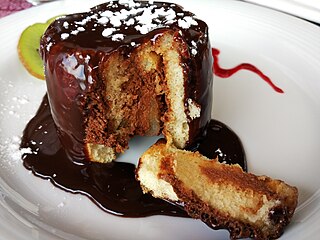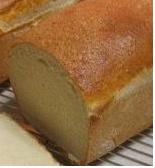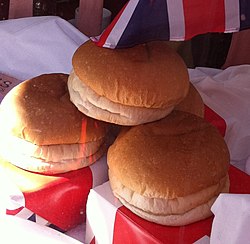
A scone is a traditional British baked good, popular in the United Kingdom and Ireland. It is usually made of either wheat flour or oatmeal, with baking powder as a leavening agent, and baked on sheet pans. A scone is often slightly sweetened and occasionally glazed with egg wash. The scone is a basic component of the cream tea. It differs from teacakes and other types of sweets that are made with yeast. Scones were chosen as the Republic of Ireland representative for Café Europe during the Austrian presidency of the European Union in 2006, while the United Kingdom chose shortbread.

A muffin is an individually portioned baked product; however, the term can refer to one of two distinct items: a part-raised flatbread that is baked and then cooked on a griddle, or a quickbread that is chemically leavened and then baked in a mold. While quickbread "American" muffins are often sweetened, there are savory varieties made with ingredients such as corn and cheese, and less sweet varieties like traditional bran muffins. The flatbread "English" variety is of British or other European derivation, and dates from at least the early 18th century, while the quickbread originated in North America during the 19th century. Both types are common worldwide today.

Brioche is a pastry of French origin whose high egg and butter content gives it a rich and tender crumb. The chef Joël Robuchon described it as "light and slightly puffy, more or less fine, according to the proportion of butter and eggs". It has a dark, golden, and flaky crust, frequently accentuated by an egg wash applied after proofing.

A hot cross bun is a spiced bun usually made with fruit, marked with a cross on the top, which has been traditionally eaten on Good Friday in the United Kingdom, Ireland, Australia, New Zealand, South Africa, Canada, India, Pakistan, Malta, United States and the Commonwealth Caribbean. They are available all year round in some places, including the UK.

A bakery is an establishment that produces and sells flour-based baked goods made in an oven such as bread, cookies, cakes, doughnuts, bagels, pastries, and pies. Some retail bakeries are also categorized as cafés, serving coffee and tea to customers who wish to consume the baked goods on the premises. In some countries, a distinction is made between bakeries, which primarily sell breads, and pâtisseries, which primarily sell sweet baked goods.

An English muffin is a small, round and flat yeast-leavened bread which is commonly 4 in (10 cm) round and 1.5 in (4 cm) tall. It is generally split horizontally and served toasted. In North America, Australia, New Zealand and the United Kingdom, it is frequently eaten with sweet or savoury toppings such as butter, fruit jam, honey, eggs, sausage, bacon, or cheese. English muffins are an essential ingredient in eggs Benedict and a variety of breakfast sandwiches derived from it, such as the McMuffin.

A crumpet is a small griddle bread made from an unsweetened batter of water or milk, flour, and yeast, popular in the United Kingdom, Australia, Canada, New Zealand, and South Africa.

A teacake in England is generally a light yeast-based sweet bun containing dried fruit, typically served toasted and buttered. In the U.S. teacakes can be cookies or small cakes. In Sweden, they are soft, round, flat wheat breads made with milk and a little sugar, and used to make buttered ham or cheese sandwiches. In India and Australia, a teacake is more like a butter cake. Tea refers to the popular beverage to which these baked goods are an accompaniment.

A charlotte is a type of bread pudding that can be served hot or cold. It is also referred to as an "icebox cake". Bread, sponge cake, crumbs or biscuits/cookies are used to line a mold, which is then filled with a fruit puree or custard. The baked pudding could then be sprinkled with powdered sugar and glazed with a salamander, a red-hot iron plate attached to a long handle, though modern recipes would likely use more practical tools to achieve a similar effect.

The Bath bun is a sweet roll made from a milk-based yeast dough with crushed sugar sprinkled on top after baking. Variations in ingredients include enclosing a lump of sugar in the bun or adding candied fruit peel, currants, raisins or sultanas.

Cozonac or Kozunak is a sweet yeast dough that can be used to make different traditional holiday breads and cakes. Often mixed with raisins, it can be baked as a loaf or rolled out with fillings like poppy seed or walnuts. It is common throughout Southeastern Europe in countries such as Romania, Moldova, Bulgaria, Serbia, North Macedonia and Greece. Rich in eggs, milk and butter, it is usually prepared for Easter in Romania, Serbia, Bulgaria, and in Romania and Moldova it is also traditional for Good Friday, in a simplified version with vegan ingredients, without eggs or milk - named Cozonac de post - to be eaten by Christians during lent. The name comes from the Bulgarian word for hair-коса/kosa, or Greek: κοσωνάκι, romanized: kosōnáki, a diminutive form of κοσώνα, kosṓna.

Manchet, manchette or michette is a wheaten, yeast-leavened bread of very good quality, or a small flat circular loaf. It was a bread that was small enough to be held in the hand.

Cardamom breads, including the Finnish pulla and Swedish kardemummabröd and kardemummabullar, are a group of enriched breads or pastry flavored with cardamom. They are eaten throughout the year, typically with coffee or tea.

Tea has long been used as an umbrella term for several different meals. English writer Isabella Beeton, whose books on home economics were widely read in the 19th century, describes meals of various kinds and provides menus for the "old-fashioned tea", the "at-home tea", the "family tea", and the "high tea".

English Bread and Yeast Cookery is an English cookery book by Elizabeth David, first published in 1977. The work consists of a history of bread-making in England, improvements to the process developed in Europe, an examination of the ingredients used and recipes of different types of bread.
















